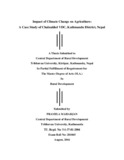Please use this identifier to cite or link to this item:
https://elibrary.tucl.edu.np/handle/123456789/2287| Title: | Impact of Climate Change on Agriculture |
| Other Titles: | A Case Study of Chalnakhel VDC, Kathmandu District, Nepal |
| Authors: | Maharjan, Pramila |
| Keywords: | Climate Change;Agricultural Production;Temperature |
| Issue Date: | 2016 |
| Publisher: | Central Department of Rural Development Tribhuvan University, Kathmandu |
| Abstract: | The climate change generally refer change in rainfall and temperature pattern which affects several sectors including agriculture and water resources. This study attempts to find the impact of climate change on agricultural sector of Chanlakhel VDC, Kathmandu, Nepal. The study includes the analysis of pattern and trend of rainfall and temperature based on hydrological and meteorological data (1985 to 2014) of study area, pests and disease problem on study area because of cc, and impact of cc on agriculture sector (both crop farming and livestock husbandry) of study area. Precipitation and temperature are the main parameters of climate change. The changing pattern of rainfall and temperature can impact on agricultural sector of any place either positively or negatively. From 30 years analysis of rainfall, there observed fluctuate and slight change in rainfall pattern per year. The heaviest annual mean rainfall was 137.758mm recorded in year 2011. The minimum annual mean rainfall was 68.267mm recorded in year 1992. That means 69.491mm rainfall difference in annual rainfall of 2011 and 1992. Mean rainfall of monsoon is not same there is also difference in rainfall. Maximum mean rainfall of monsoon was 371.967mm recorded in year 2011 and minimum mean rainfall of monsoon was 171mm recorded in year 2005. Similarly maximum mean winter rainfall was80.2mm recorded in year 2007 and minimum mean winter rainfall was 0.5mm in the year 1985 and no winter rainfall in the year 1999, 2006, 2008 and 2009. From data analysis of temperature, the warmest year was 1999 where maximum mean temperature was 25.808 degree celsiuswas recorded on that year and minimum annual mean temperature was 18.95 degree celsius recorded on the year 1997. And that analysis show temperature is slightly increasing. Hence agricultural production of the study area decreasing because of climate change. Increasing temperature, changing pattern of rainfall are the indicator of climate change, which affect agricultural sector negatively. Hence climate change introduced several consequences which result have been facing by human beings. Climate change also affect livestock husbandry negatively. So pattern of livestock has been also changed. There is decreasing in number of livestock due to reduced fodder resources and pasture area. 7 |
| URI: | http://elibrary.tucl.edu.np/handle/123456789/2287 |
| Appears in Collections: | Rural Development |
Items in DSpace are protected by copyright, with all rights reserved, unless otherwise indicated.

